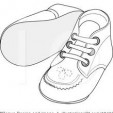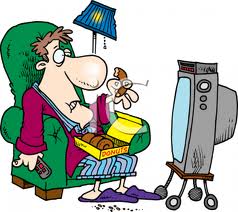Buying the Right Shoes Infants don’t need shoes, but once your baby starts learning to walk, proper footwear provides much-needed protection. Here’s what to look for when shoe-shopping: Children learning to walk should wear shoes made of soft, lightweight materials. Soles with rubber grips can be a good idea if your floors are slippery. Make sure the shoes are long and wide enough, with some room to grow. The toes shouldn’t hit the front of the shoe. Comfort is most important for babies learning to walk. Shoes should fit well in the store; kids don’t “break in” uncomfortable shoes. Tripping and limping are signs of discomfort. Look for breathable materials, like leather or canvas, because baby feet sweat a lot. Buy new shoes often. Your baby’s feet grow quickly, so he’ll need a new pair every two to four months. Article from WebMD Read more here American Orthopaedic Foot & Ankle Society. [ http://www.aofas.org/footcaremd/how-to/footwear/pages/how-to-select-children’s-shoes.aspx ] (How to Select Children’s Shoes) disclaimer: http://www.livingnotesoflife.com/disclaimer/...
Health Tips
What Is a Heart Attack? A heart attack occurs when the flow of oxygen-rich blood to a section of heart muscle suddenly becomes blocked. If blood flow isn’t restored quickly, the section of heart muscle begins to die. Heart attacks are a leading killer of both men and women in the United States. Excellent treatments are available for heart attacks. These treatments save lives and prevent disabilities. Treatment works best when it’s given right after symptoms occur. If you think you or someone else is having a heart attack, call 9–1–1 right away. 12 Possible Heart Symptoms Never to Ignore continued… Heart disease is the No. 1 killer of U.S. men and women, accounting for 40% of all U.S. deaths. That’s more than all forms of cancer combined. Why is heart disease so deadly? One reason is that many people are slow to seek help when symptoms arise. Yes, someone gripped by sudden chest pain probably knows to call 911. But heart symptoms aren’t always intense or obvious, and they vary from person to person and according to gender. Because it can be hard to make sense of heart symptoms, doctors warn against ignoring possible warning signs, toughing them out, waiting to see if they go away, or being quick to blame them on heartburn, muscle soreness, or other less serious, noncardiac causes. That’s especially true for men and people over 65, as well as for people with other cardiac risk factors, such as high cholesterol or blood pressure, obesity, smoking, diabetes, or a family history of heart disease. Here are some Signs and Symptoms that may signal heart trouble. 1. Anxiety. Heart attack can cause intense anxiety or a fear of death. Heart attack survivors often talk about having experienced a sense of “impending doom.” 2. Chest discomfort. Pain in the chest is the classic symptom of heart attack, and “the No. 1 symptom that we typically look for,” . But not all heart attacks cause chest pain, and chest pain can stem from ailments that have nothing to do with the heart. Heart-related chest pain is often centered under the breastbone, perhaps a little to the left of center. The pain has been likened to “an elephant sitting on the chest,” but it can also be an uncomfortable sensation of pressure, squeezing, or fullness. “It’s not unusual for women to describe the pain as a minor ache,” Women, more so than men, can also experience a burning sensation in their chest, rather than a pressure or pain. “Sometimes people make the mistake that the pain comes from a stomach problem,” 3. Cough. Persistent coughing or wheezing can be a symptom of heart failure — a result of fluid accumulation in...
“For ye are bought with a price: therefore glorify God in your body, and in your spirit, which are God’s.” (1 Corinthians 6:20 KJV) Taking Care of Your Body Some of us haven’t learned to love our bodies enough to properly care for them. To change that, we must confront the three biggest obstacles to healthy living. We don’t know how to care for our bodies. Bad diets, misinformation, and fast foods have confused people about what a wholesome diet is and how to eat the right foods in proper amounts. Our view of body image is skewed by media and advertising. We’re bombarded with unattainable ideals of beauty, while obesity is so prevalent that it’s almost considered normal. We need to rediscover what a healthy person looks like. Exercise is nearly obsolete. We’ve invented enough conveniences that we often live completely void of exercise. We don’t even walk anywhere if we don’t have to! But the truth is, a good deal of our well-being is dependent on exercising our bodies. If you struggle with these obstacles, make a decision today that you will not be defeated. God tells us to treat our bodies well, and He will always help us do the things He tells us to do. So make a decision to rely on God’s strength and live a healthier lifestyle. Prayer Starter: God, I want to honor You by taking care of my body and living a healthy life. I believe that I can make changes through Your power that is at work in me.- [Joyce Meyer: Promises For Your Everyday...
Facts about sedentary lifestyles: Estimates indicate that nearly 250,000 deaths per year in the US — about 12 percent of total deaths — are due to a lack of regular physical activity. Surveys show that only 22 percent of American adults get enough leisure-time exercise to achieve cardiovascular fitness. The 1991-92 Behavioral Risk Factor Surveillance Study data show the following have a sedentary lifestyle: Caucasian population — 56.2 percent men and 56.4 percent women African-American population — 62.8 percent men and 67.7 percent women Hispanic population — 61.5 percent men and 61.9 percent women Asian/Pacific Islanders — 56.6 percent men and 64.7 percent women American Indian/Alaskan Natives — 50.8 percent men and 64.1 percent women It has also been found that people with lower incomes and less than a 12th grade education are more likely to lead a sedentary lifestyle. Thirty-eight percent of people age 55 and older report essentially sedentary lifestyles. One National Children and Youth Fitness Study found that: at least half of youth do not engage in physical activity that promotes long-term health. less than 36 percent of elementary and secondary schools offer daily physical education classes. most classes were unlikely to foster lifelong physical activity. Source: Risks of Physical Inactivity – Maryland Heart Center | University of Maryland Medical Center http://umm.edu/programs/heart/health/the-heart/inactivity#ixzz2fd7YeV00 University of Maryland...
Appetites and Passions “Abstain from fleshly lusts, which war against the soul,” is the language of the apostle Peter. Many regard this text as a warning against licentiousness only; but it has a broader meaning. It forbids every injurious gratification of appetite or passion. Let none who profess godliness regard with indifference the health of the body, and flatter themselves that intemperance is no sin, and will not affect their spirituality. A close sympathy exists between the physical and the moral nature. Any habit which does not promote health, degrades the higher and nobler faculties. Wrong habits of eating and drinking lead to errors in thought and action. Indulgence of appetite strengthens the animal propensities, giving them the ascendency over the mental and spiritual powers. – {HR November 1, 1882 Par. 1} The Health Reformer: Ellen G. White 1 Peter 2:11 King James Version (KJV) 11 Dearly beloved, I beseech you as strangers and pilgrims, abstain from fleshly lusts, which war against the...
Inactivity is a fruitful cause of disease. Exercise quickens and equalizes the circulation of the blood, but in idleness the blood does not circulate freely, and the changes in it, so necessary to life and health, do not take place. The skin, too, becomes inactive. Impurities are not expelled as they would be if the circulation had been quickened by vigorous exercise, the skin kept in a healthy condition, and the lungs fed with plenty of pure, fresh air. This state of the system throws a double burden on the excretory organs, and disease is the result. – {MH 238.1} ~~Ellen G White: Ministry of Healing “don’t suddenly take up vigorous exercise after years of inactivity” Inactivity : the state of being inactive; idleness. An absence of physical activity and/or exercise, a predictor of obesity. inactivity – Discussion – Medical Dictionary – The Free Dictionary obesity is caused most of the times due to laziness, and that leads to heart, musculo-skeletal problems and even cancer…….being lazy affect every aspect and every system in our body, from the central nervous system to kidney and urinary system. Risks of Physical Inactivity What health risks are associated with physical inactivity? Lack of physical activity has clearly been shown to be a risk factor for cardiovascular disease. Less active, less fit persons have a 30 to 50 percent greater risk of developing high blood pressure. Although no direct link exists between regular exercise and stroke, it is known that exercise reduces the risk of other health problems, such as heart disease, which can contribute to stroke. Source: Risks of Physical Inactivity – Maryland Heart Center | University of Maryland Medical Center http://umm.edu/programs/heart/health/the-heart/inactivity#ixzz2fd4VvedU University of Maryland Medical Center Follow us: @UMMC on Twitter | MedCenter on...




